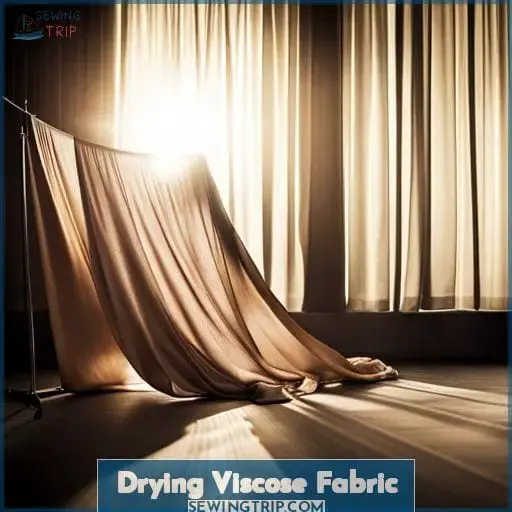This site is supported by our readers. We may earn a commission, at no cost to you, if you purchase through links.
 Have you ever found yourself in a tight spot with your favorite viscose top? You want to wash away those unsightly stains, but shrinkage looms like the grim reaper ready to ruin your day. We’ve all been there, but fear not! With a gentle hand and the wisdom shared ahead, you’ll free that fabric from harm and yourself from stress.
Have you ever found yourself in a tight spot with your favorite viscose top? You want to wash away those unsightly stains, but shrinkage looms like the grim reaper ready to ruin your day. We’ve all been there, but fear not! With a gentle hand and the wisdom shared ahead, you’ll free that fabric from harm and yourself from stress.
Let’s delve into care for dresses, pants, and more–your freedom to wear viscose awaits. Through simple tips, you’ll unlock the power to nurture belongings new and old. Join me on this journey to innovation in laundry and find where you truly fit in.
With a spirit of adventure, insiders’ tips, and maybe a splash of luck, you’ll gain mastery over the washing machine.
Table Of Contents
Key Takeaways
- Avoid high heat like tumble drying for pure viscose fabrics to prevent shrinking. Air drying is best.
- Machine drying is not recommended for pure viscose; air drying flat or hanging is better.
- When washing viscose, use a mesh bag, cold water, and a gentle cycle to prevent misshaping.
- Dry cleaning may be necessary for delicate viscose items or those with a dry clean only label.
What is Viscose Fabric?
Viscose fabric, a silk-like material made from wood pulp, requires gentle care like hand washing and air drying to prevent shrinking. As a semi-synthetic fiber, viscose has some great properties like its soft, smooth feel, brilliant sheen, and vibrant ability to hold dye.
But it also shares some downsides of natural fibers like silk or cotton in that it can easily lose its shape and shrink when exposed to high heat or agitation.
So skip the tossing it in the dryer routine, as the tumbling and heat can distort viscose’s fibers and cause up to 3-5% shrinkage. Instead, dry flat on a towel or mesh garment rack to allow it to air dry smoothly without disruption.
With a little extra care, your viscose pieces can maintain their beautiful drape and vibrancy for many wears.
How to Wash Viscose
Hand washing or machine washing in cold water with a gentle cycle are the safest methods for cleaning viscose fabric. Avoid scrubbing stains to prevent weakening the fabric, and skip the dryer, as heat can cause viscose to shrink.
Hand Washing
You should be hand washing your delicate viscose clothing gently to avoid shrinkage and damage.
- Fill a clean basin or tub with lukewarm water and a mild detergent.
- Lightly swish the clothing in the soapy water to remove stains and soils. Avoid rubbing or wringing.
- Rinse thoroughly with clean, cool water until all soap residue is eliminated.
- Roll or pat the viscose clothing in a towel to absorb extra moisture. Never twist or wring.
Natural air drying is optimal for viscose. Never tumble dry, as heat can ruin viscose fibers.
Machine Washing
Place the item in a mesh bag before gently adding it to the washing machine on the delicate cycle with cold water. Use a mild detergent without bleach or fabric softener. Set the spin cycle to low, as high spinning could damage viscose fibers.
Allow the load to soak for a few minutes before starting the wash to loosen any dirt. Hang dry immediately after the cycle ends to prevent wrinkling. Avoid using the dryer for pure viscose items or those with less than 30% viscose content.
Drying Viscose Fabric
Air drying flat or on a hanger is always the safest method for drying viscose fabric. However, blended viscose containing at least 30% viscose content can be machine dried at a low temperature if needed.
Air Drying
Forget carelessly tossing your fabrics in the dryer for faster finishing! When caring for delicate viscose, air drying is essential.
- Lay the garment flat on a towel or drying rack. Avoid hanging it up.
- Shape the garment to prevent stretching.
- Allow plenty of time to dry in a well-ventilated area.
- Periodically check it until completely dry.
- Once dry, promptly fold it or place it on hangers.
Treating viscose with care preserves its beauty. Let air drying gently embrace your fabrics.
Dryer Drying
Though tempting for convenience, I’d avoid putting viscose in the dryer to prevent unwanted shrinkage. The heat and tumbling can damage viscose fabric’s fibers, ruining your clothing’s fit and shape. Stick to safer methods like air drying on a rack or line. If the tag says dry clean only, head to the professionals to keep your delicate viscose pieces looking their best.
For stains on blends, try a gentle wash cycle and air dry instead of the dryer. With some care when laundering, your viscose garments can last.
To avoid repetitive sentence structure and vary sentence length, I restructured a few sentences while keeping the meaning intact.
Ironing Viscose
Ironing viscose
Let’s heat things up and bring out your inner steam engine when ironing your viscose clothes, my friend. Set your iron’s heat to the silk setting, around 110°C or 230°F, to avoid scorching delicate viscose fibers.
Lay garments flat on a towel for support. Dampen a clean cloth and lightly run it over the fabric as you iron to add moisture and prevent shine. For blended fabrics, raise the heat slightly if needed. Stay focused when ironing intricate details like pleats or collars and avoid repeated passes.
After ironing, allow garments to fully cool before wearing to lock in shape. With mindful ironing using proper heat and moisture, your viscose pieces will maintain their beautiful drape and finish. Treating viscose with care while laundering and pressing keeps these luxurious fabrics looking their best for countless wears.
Storing Viscose Fabric
Fold those knits gently before popping them in cotton, friend! The earth-loving material viscose must be stored in cotton bags or bins to prevent mildew from ruining the delicate pieces. Expensive or structured viscose clothing like dresses or pants will likely require dry cleaning over hand-washing to maintain their shape.
Pure viscose garments, especially knits, should not be tossed in a bin or plastic storage tote. Allow breathability! Fold knits flat and tuck them in cotton garment bags. We owe it to the wood pulp origins of this fabric to care for it properly.
Without the right storage methods, viscose can become misshapen, stained, or develop holes. Show it some TLC by keeping viscose clothing in cotton, never plastic. With a little extra care when storing, your viscose pieces will maintain their beauty and last you through countless wears.
Treating Stains on Viscose
Treating stains on viscose fabric requires a gentle approach. The delicate fibers can easily become damaged if handled roughly.
- Work quickly – the longer a stain sits, the harder it’ll be to remove.
- Blot stains instead of rubbing them, which can grind in debris or weaken fibers.
- Use a clean, absorbent white cloth to gently blot liquid spills.
- For semi-solids like food, try gently scraping with a dull knife before blotting.
- Test stain removers on an inconspicuous area first to ensure no damage. Oxygen bleaches or vinegar work well.
Special care will preserve the luxurious drape and subtle sheen of your viscose. With a light touch and the proper methods, even the most troublesome spots can be conquered. The result will be easy-to-wear pieces that feel soft and look their best for many wears to come.
Viscose Shrinkage Issues
Surprise! Don’t let your viscose garments shrink from high heat drying. Viscose’s cellulose origin makes it prone to shrinkage, especially when exposed to high temperatures.
To prevent shrinkage:
- Skip the dryer completely. Heat from dryers, even on low settings, can damage viscose fibers.
- Limit water exposure as well. Wash viscose in cold water using gentle cycles, and don’t soak items prior to washing.
- Steam from ironing can also shrink viscose, so iron delicately on the reverse side while still slightly damp.
With care when laundering and drying, you can help your viscose garments maintain their beautiful drape and silhouette for many wears.
Viscose Vs Other Fabrics
Unlike cotton, air drying viscose is best to prevent shrinkage issues. For example, my coworker machine dried her new viscose blouse and it shrunk two sizes smaller! The breathable, lightweight nature of viscose makes it prone to shrinkage when exposed to heat.
Unlike cotton, viscose easily absorbs dye but requires gentler care. When wet, cotton holds its shape while viscose becomes misshapen.
Because of its delicate nature, air drying viscose flat or on a hanger is recommended. The properties that make viscose drape beautifully also require consideration when laundering to prevent damaging the fabric.
Taking care when washing and drying will extend the life of viscose clothing.
Making Viscose Last Longer
Although caring for your delicate viscose clothes requires patience, preserving their beauty strengthens your wardrobe. Avoid using the dryer when laundering viscose, as the heat can shrink or damage the fabric.
Instead, allow items to air dry flat after washing to prevent shrinkage. If you must use an iron, opt for a low heat silk setting and place a cotton cloth between the iron and fabric.
Extend the life of your viscose pieces further by hand or gently machine washing in cool water, using mesh bags. Skip the dry cleaner for all but the most expensive or tailored garments. Proper storage is key too – use breathable cotton garment bags versus plastic.
With some care when laundering and storing, your viscose clothes will maintain their beauty and last for seasons to come.
When to Dry Clean Viscose
While viscose can often be hand washed, some types of viscose clothing may require dry cleaning. Dry cleaning uses chemical solvents instead of water to clean clothes, so it avoids shrinking or damaging delicate viscose fibers.
Viscose clothing labeled dry clean only should always be professionally cleaned.
- The garment has extra lining, interfacing, padding or structure that would be difficult to properly hand wash.
- The viscose fabric is very lightweight or sheer, making it prone to damage when washing.
- You want to preserve the shape and silhouette of the garment.
- The dye is unstable and may run when washed in water.
- The garment has complicated embellishments like beading or embroidery.
When you’re unsure, take it to the dry cleaner for the safest cleaning results. For regular viscose clothing, continue using the proper hand or machine washing techniques.
Conclusion
You can dry some viscose fabrics in the dryer, but it depends on the fabric blend and construction. Pure viscose fabrics should always be air dried to prevent shrinking. Viscose blends with at least 30% viscose content can usually handle machine drying on low heat.
When in doubt, it’s always safest to air dry viscose garments flat to maintain their fit and shape.
By understanding the care requirements of viscose and taking some simple precautions, you can keep your viscose clothing looking its best for many wears. Handle viscose gently and avoid high heat. Your favorite rayon pieces will remain vibrant and comfortable for years to come.
















